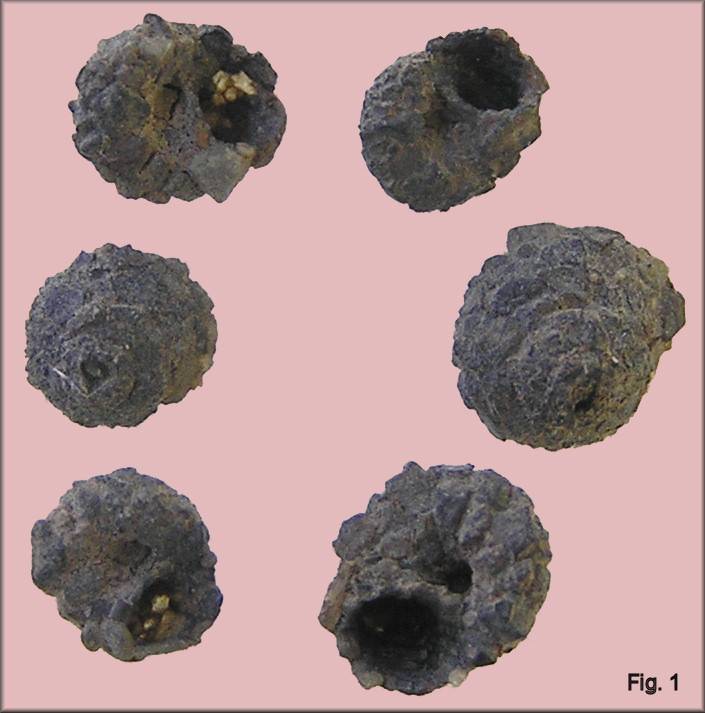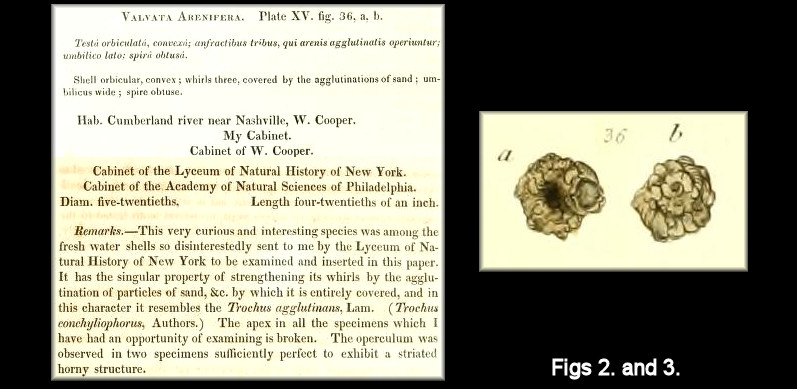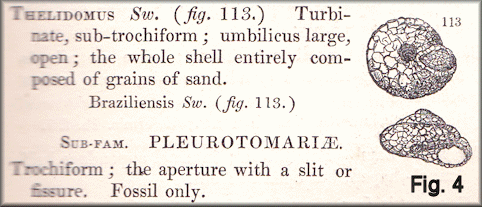|
An ersatz Valvata from Bernheim Forest Kentucky |
|
by Harry G. Lee |
|
The intersection of mollusk shells and productions of
creatures assigned to other phyla was imprinted in my mind
early on. As a college freshman,
I found several specimens of an unfamiliar ~ 5 mm.
snail living on rocks at the bottom of
a brook tributary of the Hoosic River in Williamstown, MA. Only after a
few days had passed, when I viewed them under the stereoscope in
the biology lab, did I see that these shells were composed of cemented
mineral grains and each contained a bristly worm-like critter. The "conchological"
resemblance to certain species of the genus Valvata, e.g., <http://www.jaxshells.org/p10034.htm>,
however, was nonetheless still quite uncanny. I regret that I promptly lost track of these MA specimens, but in 1976 I placed some similar specimens collected by a botanist friend from a creek near Piha Beach, Watakaries, North Is., New Zealand in my collection. A third encounter occurred on October 19, 2014 when I found another bunch of these oddities living on small nearshore rocks at the confluence of Wilson and Harrison Creeks in the Bernheim Arboretum and Research Forest Nelson-Bullitt Cos., KY [Fig. 1]. The habitat was eerily reminiscent of my first encounter over a half-century before, and the find launched a "cold case" investigation into this mystery. |
|
|
| Over a century before the first of the above events, Philadelphian Isaac Lea, who with some regret I must admit is neither an ancestor or even a close relative of mine, had a similar encounter. Lack of kinship notwithstanding, Dr. Lea shared my initial read on such "shells," and dubbed them Valvata arenifera [Latin: sand-bearing] (I. Lea, 1831: 104-105, pl. 15, figs. 36a, b) [Figs. 2 and 3]. Although apparently of opposite (counterclockwise) growth, these objects are quite reminiscent of my MA material. The Quaker's specimens came from Nashville, TN, where they were taken from the Cumberland River. Lea convinced himself he saw opercula in his specimens, and he believed the agglutinated mineral matter was simply a reinforcement of the snails' shells. |
|
|
|
The following year Constantine Rafinesque (1832: 122; fig. on p. 121 <http://tinyurl.com/qzqayzn>) named a "new tubular fresh water shell of the Alleghany [sic] Mts." Psephides paradoxa n. gen., n. sp. Not certain it was the production of a mollusk, he did write: "This strange shell has something mysterious in it. It appears a mass of gravel; strongly cemented ..." The figure depicts a tubular structure of the same fabric seen in my and Lea's shells. Although "conchologically" quite distinct, I think neither Lea nor Rafinesque, would find the eventual taxonomic proximity, not to mention placement, of their respective species anything short of incredible. Nearly as incredible is the fact that no further mention of the Rafinesque genus (or species) except Neave could be found in the literature. Not much
later Thomas Swainson (1840) treated a
shell
looking even more like my MA specimens, his
Thelidomus braziliensis, as a gastropod mollusk. The
nomenclatorial context of this action was almost as bizarre as the
animal involved and would benefit from a short explanation. The
author actually proposed the genus-group Thelidomus twice -
and in the same work (1840: 191-192, 330; and 228, 353)! The first
usage appears without mention of any constituent species on p.
191-192. That taxon was made available on p. 330, where its monotype
is given as Helix striolata Guilding [now known to be a
synonym of the "camaenid" H. incerta Férussac, 1821]. The
second usage of this generic epithet initially pops up on p. 228
next to text figure 41, which depicts a "shell" very much like mine
but with no associated species group name. On p. 353 the name
Thelidomus reappears again with the same text figure (now no.
113). However, this time "Braziliensis Sw[ainson]," the
monotype, appears in the text block [Figure 4].*
Years later, the Fist Reviser, Pilsbry (1894: 96) remedied this
shocking example of Swainsonian homonymy. He gave the land snail
seniority based on
* Note the following entry stating that pleurotomarians were known
only as fossils. The first living species, dubbed Pleurotomaria
quoyana by Paul Fischer and A.C. Bernardi the same year as von
Siebold named Helicopsyche <http://www.jaxshells.org/quoyana.htm>,
was discovered in 1855, 15 years later (Dance, 1969: 47). Dance, S.P., 1969. Rare Shells. University of California Press, Berkeley. (1)-128 + 24 plates. ICZN (International Commission for Zoological Nomenclature), 1999. International Code for Zoological Nomenclature Fourth Edition. International Trust for Zoological Nomenclature, London. pp. 1-306 + i-xxix. <http://www.nhm.ac.uk/hosted-sites/iczn/code/> Lea, I., 1831. Observations on the naiades and descriptions of new species of that and other families. Transactions of the American Philosophical Society 4: 63-121 + pls. 3-18. <http://www.biodiversitylibrary.org/item/79816#page/85/mode/1up> Pilsbry, H. A., 1893-1895. Manual of Conchology (second series) 9. Helicidae, vol. 7; index to the helices. Academy of Natural Sciences, Philadelphia. frontispiece + xlviii + 1-366 + 71 pls. Nov. 16 to April. <http://www.biodiversitylibrary.org/item/16303#page/9/mode/1up> Rafinesque, C.S., 1832. (Article) 22. Conchology. - A new tubular fresh water shell of the Alleghany [sic] Mts. The Atlantic Journal and Friend of Knowledge 3: 121-122. <http://tinyurl.com/k2qpc4y> Swainson, W.,
1840. A treatise on malacology; or the natural classification of
shells and shellfish. London. vii + 419, figs. <https://archive.org/details/treatiseonmalaco00swai> |


 "position
priority" (page number 330 vs. 353), an attribute which no longer
mandates such preference, and thereby rendered Thelidomus Swainson, 1840: 353 non
Swainson 1840: 330 permanently invalid.
"position
priority" (page number 330 vs. 353), an attribute which no longer
mandates such preference, and thereby rendered Thelidomus Swainson, 1840: 353 non
Swainson 1840: 330 permanently invalid.